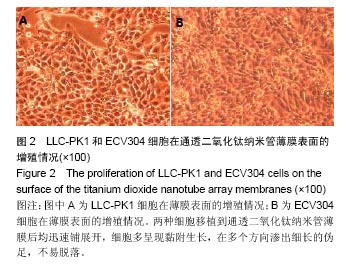中国组织工程研究 ›› 2017, Vol. 21 ›› Issue (26): 4167-4171.doi: 10.3969/j.issn.2095-4344.2017.26.012
• 纳米生物材料 nanobiomaterials • 上一篇 下一篇
二氧化钛纳米管生物透析膜的生物相容性
高钰寒,王胜男,王彪彪
- 新乡医学院,河南省新乡市 453003
Biocompatibility of titanium dioxide nanotube bio-dialysis membrane
Gao Yu-han, Wang Sheng-nan, Wang Biao-baio
- Xinxiang Medical University, Xinxiang 453003, Henan Province, China
摘要:
文章快速阅读:
.jpg)
文题释义:
透析膜:是一种以浓度差为推动力的分离膜,根据分离的溶质粒径,要求渗析膜上有相适应的孔径均匀的微孔,膜孔径在1 μm以下的有机高聚物的均质膜,是一类不带电荷的多孔膜,目前主要用于人工肾的纤维素渗析膜。常用的制备材料有铜氨法再生纤维素、醋酸纤维素、聚丙烯腈、乙烯-乙烯醇共聚物以及聚甲基丙烯酸甲酯、聚砜、聚丙烯酰胺等。
溶血实验:是对人体内的红细胞进行红细胞破裂溶解检测,主要用于溶血性贫血的病因诊断。溶血是指红细胞破裂溶解现象,很多理化因素都可以引起溶血,其正常值为24 h不加葡萄糖管溶血率小于4.5%,加葡萄糖或加ATP管溶血率小于0.4%。
背景:传统的透析膜多由有机聚合物材料合成,这些材料虽然能满足治疗需要,但材料孔径尺寸范围较大,微管不均匀,容易造成蛋白质在透析膜上淤塞,难以达到预期的治疗效果。
目的:分析二氧化钛纳米管生物透析膜的血液相容性。
方法:根据阳极氧化法制备高强度的二氧化钛纳米管薄膜,利用HF气体对纳米管底部进行腐蚀,获得两端通透的二氧化钛纳米管阵列薄膜,将LLC-PK1细胞和ECV304细胞分别接种于二氧化钛纳米管阵列薄膜上,获得两种二氧化钛纳米管生物透析膜。①溶血实验:将两种二氧化钛纳米管生物透析膜及聚氨酯材料分别浸泡于生理盐水与蒸馏水中,检测溶血率;②动态凝血时间实验:将涂过兔血的两种二氧化钛纳米管生物透析膜及聚氨酯材料分别与氯化钙混合,计算动态凝血时间;③血小板黏附实验:将富血小板血浆分别滴于两种二氧化钛纳米管生物透析膜及聚氨酯材料上,计算血小板黏附率。
结果与结论:①溶血实验:接种LLC-PK1细胞、ECV304细胞通透二氧化钛纳米管薄膜的溶血率均低于聚氨酯材料(0.30%,0.34%,0.56%,P < 0.05);②动态凝血时间实验:接种LLC-PK1细胞、ECV304细胞通透二氧化钛纳米管薄膜20,40,70 min的动态凝血时间显著长于聚氨酯材料(P < 0.05);③血小板黏附实验:接种LLC-PK1细胞、ECV304细胞通透二氧化钛纳米管薄膜的与聚氨酯材料相比差异无显著性意义(P > 0.05);④结果表明:二氧化钛纳米管生物透析膜具有良好的血液相容性。
中图分类号:




.jpg)